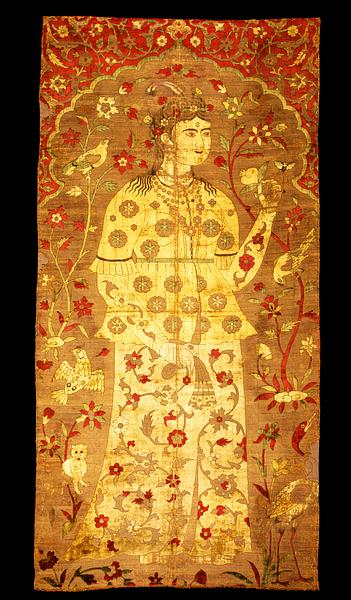Velvet, silk and silver lamella spun around silk
India or Iran; c. 1600
H: 143; W: 69 cm
The size and non-repetitive pattern of this monumental depiction of a woman standing in a lobed arch make it unique. It was first and foremost weavers from Safavid Iran who were known for making these technically unparalleled textiles, but we know from the biography of the Great Mughal Akbar that in around 1600, the Indians had come equally far in technical skill.
The colors, arch, garments, hair ornament, “caste mark,” and fairly naturalistic depiction of plants all point in the direction of India as the place of manufacture.
This textile was most probably used together with similar pieces to grace a magnificent royal tent.
Inv. no. 37/1995
Published in:
Phillips, London, 19/5-1995, lot 29;
Kjeld von Folsach: Art from the World of Islam in The David Collection, Copenhagen 2001, cat.no. 663;
Sheila S. Blair and Jonathan M. Bloom (eds.): Cosmophilia. Islamic Art from the David Collection, Copenhagen, McMullen Museum of Art, Boston College,Boston 2006, cat.no. 1;
Steven Cohen: “The use of fine goat hair for the production of luxury textiles: its origins and the similarities and differences of its use in Iran and India during the reigns of the Safavid and Mughal shahs” in Jon Thompson, Daniel Shaffer and Pirjetta Mildh (eds.): Carpets and textiles in the Iranian world 1400-1700 : proceedings of the conference held at the Ashmolean Museum on 30-31 August 2003, Oxford 2010, p. 126, fig. 3;
Rahul Jain: Rapture: the art of Indian textiles, New Delhi 2011, cat.no. 20, pp. 68-69;
Steven Cohen: “Two outstanding Mughal qanat panels in the David Collection, with technical analyses and drawings of weaving structures by Anne-Marie Keblow Bernsted” in Journal of the David Collection, 4, 2014, p. 172, fig. 2 and pp. 200-201, fig. 14;
Daniel C. Waugh: "The David Collection: Journal of the David Collection. 4," in The Silk road, 2014, 12, Featured museum, I: pp. 132-136, fig. 5;
Louise W. Mackie: Symbols of power: luxury textiles from Islamic lands, 7th–21st century, Cleveland 2015, fig. 10.8, pp. 416-417;
Sylvia Houghteling: The art of cloth in Mughal India, Princeton 2022, p. 181, fig. 4.23;
